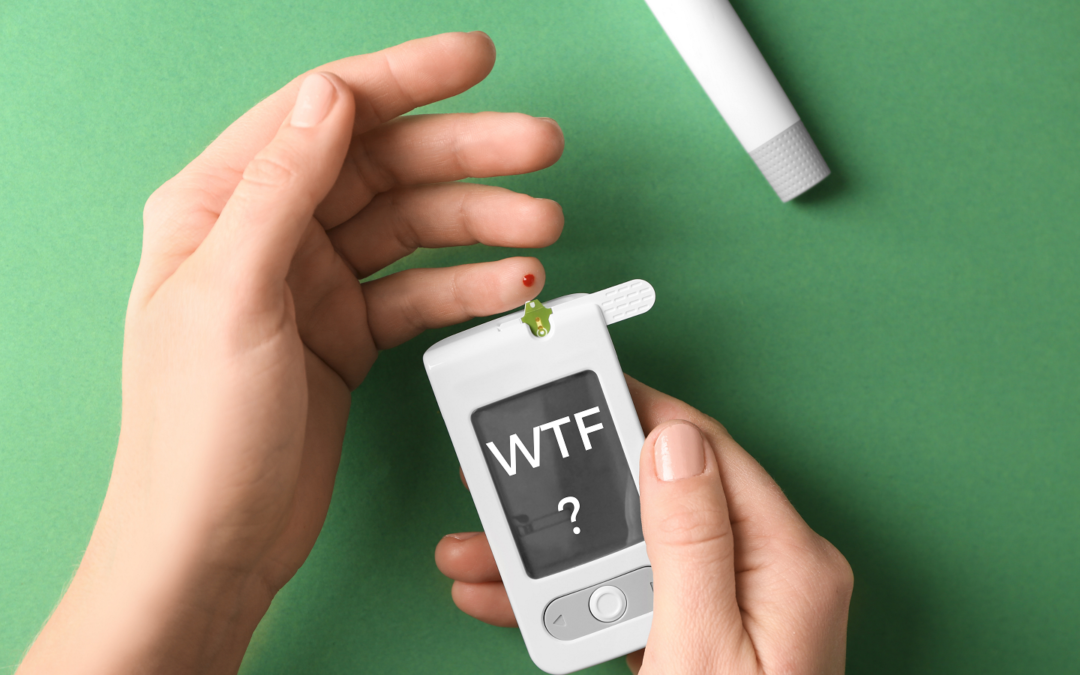There’s nothing like an unexplained high blood sugar reading in the morning to confuse and frustrate a person. Especially when you are “doing everything” to control your diabetes. 😤
I’m going to help you understand why this is happening to give you some perspective and peace. Knowing why it’s happening is comforting.
BUT: I need to also address the true cause of the frustration. And it’s not the number on your monitor.
😧🤔
This is really important to understand. Understanding this part is where you take back control of your emotional life.
It is the difference between your journey being:
- A poorly lit, winding, treacherous path full of potholes and dead ends
vs
- A meandering, colorful, scenic path with the occasional mud puddle and fallen log
Your meter is showing you a number. You see it and you think it makes you feel despair or defeat.
The truth is that the number is completely neutral. It means nothing until you give it meaning with your thoughts.
And the truth is that you get to choose your thoughts. You can choose to be curious rather than confused by simply thinking different thoughts about the number.
So don’t choose thoughts that make you quit problem solving and start catastrophizing.
Now let’s talk science. 🤓
What is happening?
Most likely, it is the Dawn Phenomenon or the Dawn Effect.
Up to 75% of Type 2 Diabetics experience it. It is VERY common. That is why I hear about it frequently from my clients and in the forums I belong to for diabetics. Up to 50% of Type 1 diabetics also see this.
However, on occasion, it is something else:
- Somogyi effect: This is rebound hyperglycemia (high blood sugar), which is in response to blood sugars dipping TOO LOW in the middle of the night. Instead of waking up shaky and sweaty, you don’t even know it is happening because your liver quickly releases stores of sugar to prevent the ensuing emergency. The way to know this is happening is to check your blood sugar around 3am to see if it is in fact low, rather than high. If confirmed as the Somogyi effect with a low reading, you will need to call your doctor for medication adjustments.
- Your meds are wearing off before the next morning dose. This can be troubleshooted with your doctor by switching up your dosing schedules.
- You ate a donut before you went to bed. 😋 Hey, at least you can’t claim to be confused!
The Dawn Phenomenon
The Dawn Phenomenon is a natural consequence of the circadian rhythm. Everyone experiences it.
In the pre-dawn hours of the morning, around 4am, your body releases a burst of several hormones to prepare you for the day ahead. These include:
- Glucagon: causes your liver to release blood sugar stores to fuel you for the day
- Adrenlin: provides energy
- Cortisol: wakes you up and activates you out of deep sleep
- Growth hormone: stimulates fat breakdown and muscle building, as well as cellular repair and protein synthesis. It has anti-insulin effects and is the main player in the Dawn Phenomenon.
This cocktail of hormones is meant to get you up and get you moving in the morning.
Your blood sugar goes up as intended by evolution. In people without diabetes, the rise is minimal because insulin is able to keep it in check. On average, you might see sugars go from 89 to 92 mg/dl.
The problem in Type 2 diabetes is that there is insulin resistance combined with a liver that is overstuffed with fat and sugar stores.
Type 2 Diabetes
In the middle of the night, you are in a fasted state. This is when insulin levels fall low and you are able to tap into your stores. The liver stores glucose in long chains, called glycogen. Also, it converts extra sugar into fat (in the form of triglycerides) for storage as well.
In a person with Type 2 diabetes, the liver has been overwhelmed with too much sugar to process. It has been storing, storing, storing for many years. It has been storing fat inside itself, which eventually interferes with its functioning. This is where non-alcoholic fatty liver disease develops, which almost always precedes a diagnosis of Type 2 diabetes.
When the liver is jam packed with stores, it is a lot like an over-full bladder. When you really, really need to pee and you finally are able to get to the toilet, the urine comes rushing out in a torrential flow.
When insulin levels fall in a fasted state, your body sends the signal to the liver (via glucagon) to release its stores. The result is a rush of glucose into the blood stream.
Combine this with insulin resistance (your body does not respond to insulin properly to bring the blood sugars down) and/or insulin deficiency (you aren’t making enough insulin) and now you have Dawn Phenomenon.
Insulin resistance is really a problem with trying to jam MORE sugar into a liver or a muscle cell that is already at maximum capacity. There just isn’t any more space. The cells are resistant to insulin shoving more where no more can fit.
Is the solution to insulin resistance giving more insulin? Or letting the stores out so that insulin can work properly?
Nothing has gone wrong
When you see what is actually going on, it is logical to ask the question, “Is this really a bad thing?”
Think about it. If you are in a fasted state, you haven’t eaten sugar. So where did all the sugar in your blood stream come from?
It’s coming from the over-stuffed stores in your liver, which is the root of insulin resistance, as I explained above.
If Type 2 diabetes is a disease of insulin resistance, and insulin resistance is driven by over-stuffed stores of glucose and fat in your body, is emptying out stores really a bad thing?
What if it just means you are allowing stores to empty so your liver to return to normal functioning?
Dawn Phenomenon is simply your body moving sugar from the liver into the blood stream where you can burn it for fuel.
Of course, if your sugar is so high that you FEEL bad, it is a problem that you can address with medications or exercise.
Usually, however, people are just displeased with the glucometer reading, and they make the number mean:
- Their diabetes is out of control
- Their medication regimen and diet are not working
- They are doing something wrong
- They are going to die a slow and terrible death
What it really means is that they have more work to do to restore their body to healthy functioning.
Make it mean:
- Keep going.
- I have more work to do.
- My liver is healing itself.
If you keep emptying stores and stop eating food that keeps you in storage mode, eventually, Dawn Phenomenon resolves itself.
Remember, it took years to reach the point of full-blown Type 2 diabetes. Healing will not occur over a few weeks. It usually takes months, or even years, to reverse the process that creates insulin resistance.
To stay the course to reach freedom from Type 2 diabetes, you will need to stay focused and committed. You will need to be curious and willing to figure it out.
This is how I help my clients stop staying stuck, stop falling into the mind drama trap, and keep taking action toward their goals. I teach the right dietary tools that reverse insulin resistance, and then we apply them with a customized plan until we get the results we want.
Reach out here to learn how to work with me:


